- Home
- Holiday Ideas
-
-
- Choose Your Traveling Theme
-
- Adventure Tourism
-
- Cultural Tourism
-
- Tour Packages
-
-
- Packages by State
-
- Holidays by Interest
-
- Popular Tour Packages
-
- Fair And Festivals
-
- Ayurveda And Yoga
-
- Offers
-
- Destinations
-
Jaisalmer Where forts are still alive
Jaisalmer
Rolling hills of honey-hued sand dunes, vast barren expanses, contrasting colours and mesmerising historical treasures, structure the stark great thing about the enchanting city of Jaisalmer, in Rajasthan. the town holds the still-inhabited Jaisalmer Fort at its heart, which seems to rise out of the desert sort of a mirage and appears ablaze because the golden rays of the sun bathe it.
...Encircled by 99 bastions, this fairytale-like-fort enthrals you with its grandeur. This far-flung city of Rajasthan invites tourists from across the world with its intricately carved temples, narrow streets and almost perfectly concealed delights, which may be explored through camel rides amidst the mystic desert. Jaisalmer features a history dating back to the prehistoric period, which is preserved within the Akal Wood Fossil Park. A must-visit is that the Tanot Mata Temple, which lies on the brink of the India-Pakistan border and have become famous during the 1965 war, when the bombs that fell near it didn’t diffuse. it’s also been featured within the movie ‘Border’,Legend has it that Rawal Jaisal, the eldest heir of the Rawal of Deoraj, was omitted the throne of Lodurva and his younger half-brother was crowned king. during a quest to redeem himself, he went trying to find a replacement capital when he found a sage who told him an ancient prophecy. This led to Rawal Jaisal constructing a mud fort within the area in 1156 and naming it Jaisalmer after himself. Jaisalmer literally translates to hill fort of Jaisal. Its location on the traditional trade routes led to the fabled riches and indulgent sort of architecture. Jaisalmer is additionally known for its wood carvings, local artistry and fabulously rich cultural heritage of humanistic discipline .
Read MoreAttractions in Jaisalmer
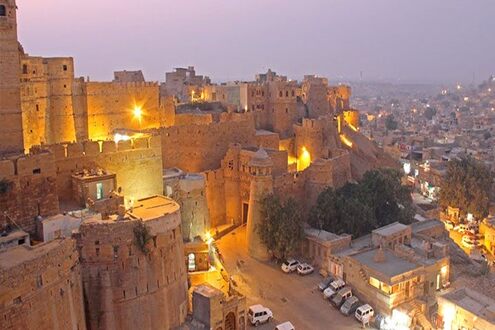
Jaisalmer Fort
The piece de resistance of the lively Thar desert may be a magnificent structure built from yellow sandstone, called the Jaisalmer Fort. Perched atop the Trikuta Hill (triple peaked hill), this imposing fort seems to rise straight from the desert and its gleaming stone fade gives the impression of it being an extension of the magnificent Thar. The magic of this architectural marvel is best witnessed at sunset when the entire fort seems ablaze because it reflects the sunshine from the setting sun, earning it a spot on the list of UNESCO World Heritage Sites. The fort is understood for its elaborately carved structure called Raj Mahal, the residence of the erstwhile royalty and therefore the beautiful Jain and Laxminath temples it’s home to.
The fort also piqued the interest of Oscar winning Indian filmmaker Satyajit Ray, who featured it in one among his films Sonar Quila or the Golden Fortress.
This imposing structure was inbuilt 1156 AD by Rajput ruler, Jaisal, and was reinforced by subsequent rulers of Jaisalmer. The fort was the main target of variety of battles between the Bhatis, the Mughals of Delhi and therefore the Rathores of Jodhpur and has four massive gateways.
Gadsisar Lake
The Gadsisar rainwater lake may be a popular picnic spot, due to its cool and scenic surroundings. In fact, it’s an excellent viewpoint to sight the spectacular Jaisalmer Fort from , when it’s bathed within the glorious hues of the golden sun at sunrise. The lake sits just outside the town walls and was once the only reservoir that controlled the whole supply of water to the arid city of Jasialmer!
Located within the southern a part of the town , the doorway to the lake is marked by beautifully carved yellow stone archway referred to as Tilon-ki-Pol. Contrary to the favored belief, it's not an oasis but a conservation tank made around 1400 AD by the then maharaja of Jaisalmer, Maharwal Gadsi Singh.
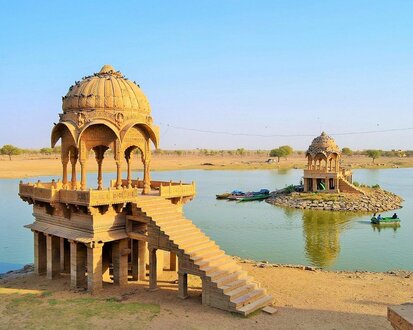
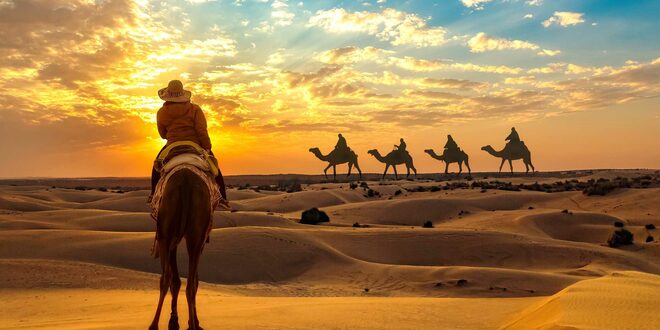
Desert Safari at Sam Sand Dunes
The pristine, breathtaking, expanse of the unbroken sand dunes of Sam makes it an excellent desert safari spot. One can enjoy desert safari by either riding a camel or by hiring a jeep. While camping within the desert, surrounded by the golden sands of the Thar desert, visitors can get an immersive insight into life within the desert. there’s tons to find out while travelling through the remote areas of Jaisalmer and absorbing the rich culture of the region with its folk dance performances,
puppet shows and other open-air cultural extravaganzas.
Located on the outskirts of Jaisalmer, the quaint village of Khuri is surrounded by pristine sand dunes. A camel ride in Khuri will take you across undulating sand dunes at a leisurely pace which will allow you to experience the bare yet beautiful landscape of the Thar desert. The relatively unexplored sand dunes hold an excellent appeal for tourists who are trying to find an shake the bustling tourist circuit. because the golden rays of the sun and therefore the unique wind patterns dance in unison at sunset and sunrise to make a light-weight and galanty show of epic proportions, one feels the pull of the straightforward and uncomplicated lifetime of the region. The nearby village features a smattering of mud huts and an area bazaar where visitors can absorb the normal Rajasthani way of life. the various resort operators offer a night's stay in beautifully prepared luxury-tents, complete with breathtaking performances by local artists. thanks to its distant location, Khuri enjoys seclusion and makes the simplest use of the undisturbed environs with the occasional campfire night, that permits guests to unwind with home-cooked meals that are traditionally prepared for an entire desert experience.
Kuldhara
On the outskirts of the town of Jaisalmer lie the ruins of the abandoned village of Kuldhara that have captivated the minds of travellers for hundreds of years . Back within the 1800s, the village wont to be a prosperous town but, it said that after some unfathomable tragedy, the town was abandoned overnight. Legend says that nobody saw the inhabitants leave the village and nobody knows the rationale for the mass exodus.
Since then, nobody has been ready to settle here. the various stories of how a neighborhood of just about thousand residents simply vanished, makes it a top priority for history buffs and thrill-seekers alike. A rehearse this desolate, abandoned village within the desert with its houses, roads and a temple is an experience that takes you back in time. Some interesting conservation techniques are unearthed amongst the 200-year-old ruins, an interesting feat in such a water-scarce desert terrain. The abandoned houses of the village are often used as film sets. Tourists can explore the village on camel rides that are easily available throughout the tourist season.
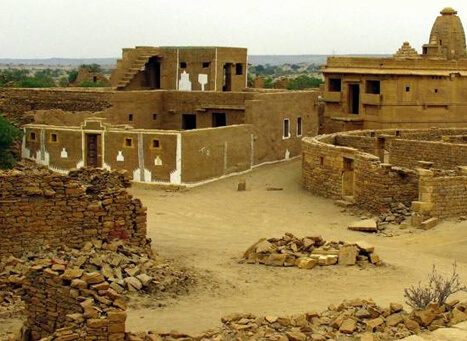
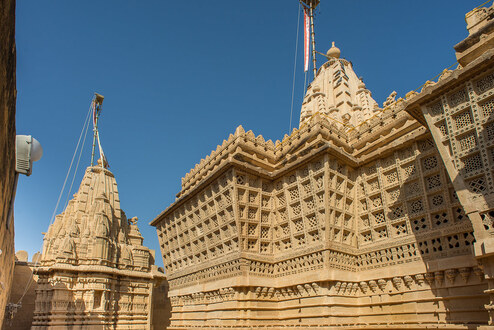
Lodhruva
Situated on the outskirts of Jaisalmer, the deserted ruins of Lodhruva, are famous for a Jain temple and a wishing tree called Kalp Vriksh. The temple is devoted to the 23rd tirthankar (saint), Parshwanath. The architectural great thing about the temple are often seen on each finely carved stone that was wont to construct it. The intricate stone carvings and enormous ,
spacious interiors bring a pleasing and relaxing time at the complex, which has been reinstated to it's pristine condition after extensive repairs and restorative work administered over the years. Lodhruva is claimed to be the setting of the doomed-love story of Princess Mumal and Mahendra, the prince of Aamarkot, recounted in local folklore and songs across the region. Ludruva is understood because the ancient capital of Jaisalmer.
Nathmal-ki-haveli
This haveli may be a perfect example of the gorgeous fusion of Islamic and Rajputana sorts of architecture. Built by two architect brothers within the 19th century, who started the development from opposite ends, this palace has similar but non-identical left and right facades. This choreographed asymmetry adds to the architectural great thing about the haveli.
Miniature style paintings and mighty tuskers carved out of yellow sandstone were used for decorating the inner chambers of the mansion. The life-size elements are now situated at the doorway and appear to be the guardians of this historic monument. it's easy to ascertain that in erstwhile Jaisalmer, the haveli was the centre of all regional activity because it is now camouflaged amongst various modern houses and narrow lanes, all of which cause the haveli. Although the haveli is partly-inhabited, you would possibly get an opportunity to go to the primary floor which has paintings beautifully decorated using gold foil .
The Nathmal-ki-haveli was commissioned to function the residence of Diwan Mohata Nathmal, the then Prime Minister of Jaisalmer. Maharawal Beri Sal commissioned the development of this haveli.
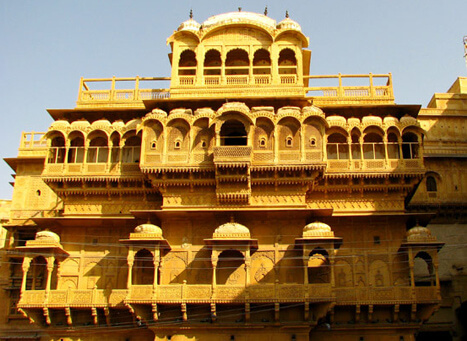
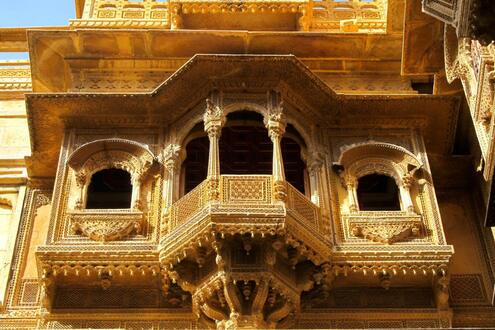
Patwon-ki-haveli
In the narrow lanes of the most city of Jaisalmer, lies the magnificent Patwon-ki-haveli, known for its pretty paintings, intricate carvings and a grandiose sort of architecture. the whole complex isn’t one haveli but a cluster of 5 smaller beautiful havelis. the primary among these havelis was commissioned and constructed in 1805 by Guman Chand Patwa.
There are a couple of paintings and mirror artwork that adorns the within walls of this grand mansion. To cater to the visitors curious about the rich cultural history of the world , one among the sections has been converted into a museum that houses several artefacts from the first 19th century. The hardwork and aesthetic skills of the local Rajasthani craftsmen are often seen in every corner of this haveli within the individual depictions and theme on each and each arch. Although the entire building is formed in yellow sandstone, the most gateway of the Patwon-ki-haveli is in brown color.
Pokhran
The heritage city of Pokhran lies at the guts of the Thar desert, about 110 km east of Jaisalmer. Literally translated, it means an area of 5 mirages, and is bound by five big salt rocks. Speckled with royal havelis, ancient temples and grand structures, Pokhran remains suspended in time. the most attraction is that the Pokhran Fort, which was the citadel of the Champawat Rathores, the mighty Rajput nobles of Marwar.
The fort has now been converted into a heritage hotel with a museum having a stimulating collection of local handicrafts and artistry. Tourists also can visit the tiny village of Ramdevra, famous for its sacred temple, which is claimed to be the ultimate resting place of Baba Ramdevji, a way revered 14th century saint who Hindus reference to be an incarnation of Lord Krishna. Between August and September, an outsized fair referred to as Ramdevra Fair attracts thousands of devotees from across the state, who visit the temple to pay their respects to the deity. Pokhran is widely known for the laboratory/underground testing facility that supervised the 1988 nuclear tests after which India was declared a full-fledged nuclear state.
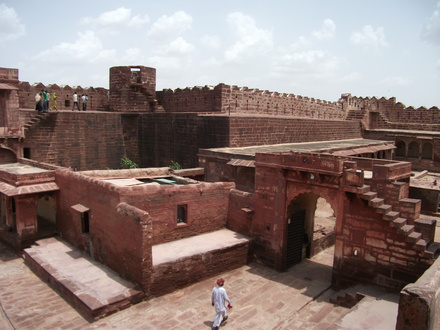
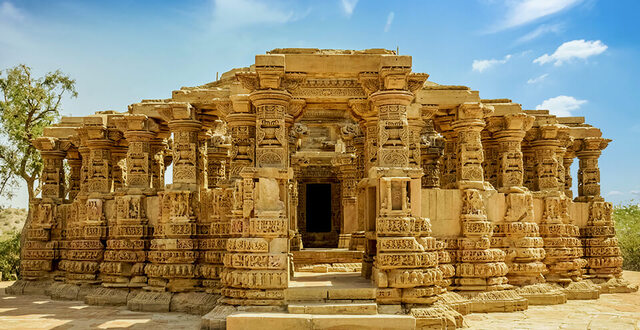
Barmer
Around 155 km faraway from Jaisalmer, lies the quaint and serene desert town of Barmer. it’s flanked by Jaisalmer within the north, Jodhpur on the east and shares a border with Pakistan within the west. it’s a neighborhood of the four largest districts that structure the Thar desert and is best known for its hand block printing industry, wood carving, pottery, colourfully embroidered traditional Rajasthani costumes and ajrak prints.
About 35 km faraway from Barmer, lie a gaggle of 5 architecturally significant temples of the erstwhile Kiradu town. The Someshwara Temple, with a multi-tiered spire, is that the most impressive. Barmer is additionally home to the Luni river, which travels about 500 km and eventually merges with the marshy land of Rann of Kutch.
The Mallinath Cattle Festival, held annually within the Tilwara village as a tribute to Rawal Mallinath, the founding father of the Mallani Pargana, a Rajput settlement, may be a major draw. Another popular attraction is that the Barmer Fort, also called Barmer Garh, which was inbuilt 1552 AD on a hillock in present day Barmer. Two important temples namely, the Jogmaya Devi (Garh Mandir) at a height of 1,383 ft and therefore the Nagnechi Mata Temple situated at a height of 500 ft were constructed to hunt the blessings of the gods for the fort's protection. Several festivals, especially during the Navratri (a holy nine-day festival) season, are hosted here.
WANT TO RENT A CAR IN INDIA ?
Choose Your Traveling Theme
















